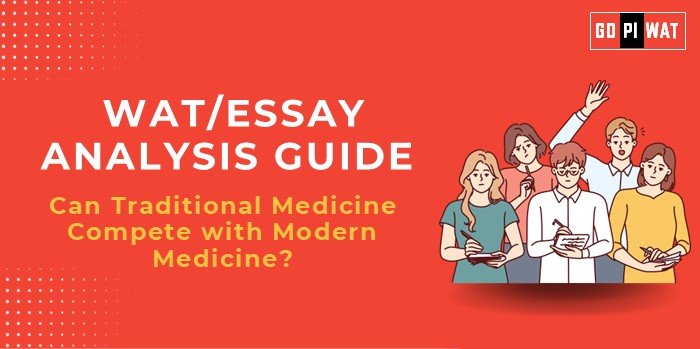📋 WAT/Essay Analysis Guide
🌐 Understanding “Can Traditional Medicine Compete with Modern Medicine?”
Importance: This topic is crucial for B-schools as it explores themes of innovation, healthcare economics, and cultural impact, encouraging a critical view on how traditional practices may contribute to sustainable health solutions.
📝 Effective Planning and Writing
- ⏱️ Time Allocation:
- Planning: 5 minutes
- Writing: 20 minutes
- Review: 5 minutes
- 📚 Preparation Tips: Identify key points regarding traditional medicine’s role in preventive care and economic potential, and note prominent organizations promoting integration.
💡 Introduction Techniques for Essays
- 🔍 Contrast Introduction: “While modern medicine often targets immediate symptom relief, traditional medicine emphasizes holistic, preventive care. Can these two approaches effectively complement each other?”
- 🔧 Solution-Oriented Introduction: “With healthcare costs rising globally, integrating traditional medicine could offer a balanced, cost-effective approach to care.”
- 📜 Historical Approach: “Traditional medicine, practiced for thousands of years, is now facing competition and potential integration with modern healthcare systems.”
📖 Structuring the Essay Body
- 🏆 Achievements:
- Economic Contribution: Traditional medicine supports local economies through jobs and trade, especially in rural areas.
- Cultural Significance: It offers culturally sensitive healthcare options.
- ⚖️ Challenges with Comparative Analysis:
- Standardization Issues: Unlike pharmaceuticals, traditional remedies often lack standardized dosages and quality controls.
- Global Comparisons: In countries like Japan and South Korea, integration models offer lessons on balancing traditional and modern methods.
- 🚀 Future Outlook:
- Potential for Integration: Growing demand for holistic health may encourage traditional medicine’s wider acceptance.
- Technological Support: Advances in digital health could help document and validate traditional practices.
🎯 Concluding Effectively
- ⚖️ Balanced Perspective Conclusion: “While traditional medicine has significant cultural and preventive benefits, it requires more rigorous validation and quality control to compete effectively with modern practices.”
- 🌎 Global Comparison Conclusion: “With successful integration models emerging worldwide, traditional and modern medicine could together address diverse health needs more effectively.”
📊 Analyzing Successes and Shortcomings
- 🏅 Achievements: Widespread acceptance, potential for preventive healthcare, economic contributions.
- 🤔 Challenges: Standardization, scientific validation, regulatory hurdles.
- 🌍 Global Context: Successful integration in countries like China and South Korea, where traditional medicine is legally recognized and regulated.
🔍 Recommendations for Sustainable Progress
- 📢 Enhanced Research: Encourage clinical trials on traditional practices.
- ⚖️ Policy Support: Governments should set frameworks for safe integration.
- 📚 Public Education: Educate consumers on the safe use of traditional and modern medicine.
📄 Sample Short Essays on “Can Traditional Medicine Compete with Modern Medicine?”
- ⚖️ Balanced Perspective: “Traditional medicine offers unique preventive approaches, but without scientific validation, it may not fully replace modern treatments. Together, these fields could meet diverse health needs.”
- 🔧 Solution-Oriented: “Integrating traditional practices with modern medicine could reduce healthcare costs and improve accessibility, especially in regions with limited healthcare infrastructure.”
- 🌍 Global Comparison: “Countries like China have shown that regulated integration of traditional and modern medicine can enhance healthcare outcomes. Such models could be a valuable reference for global health policy.”


